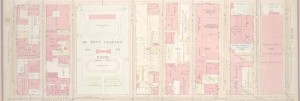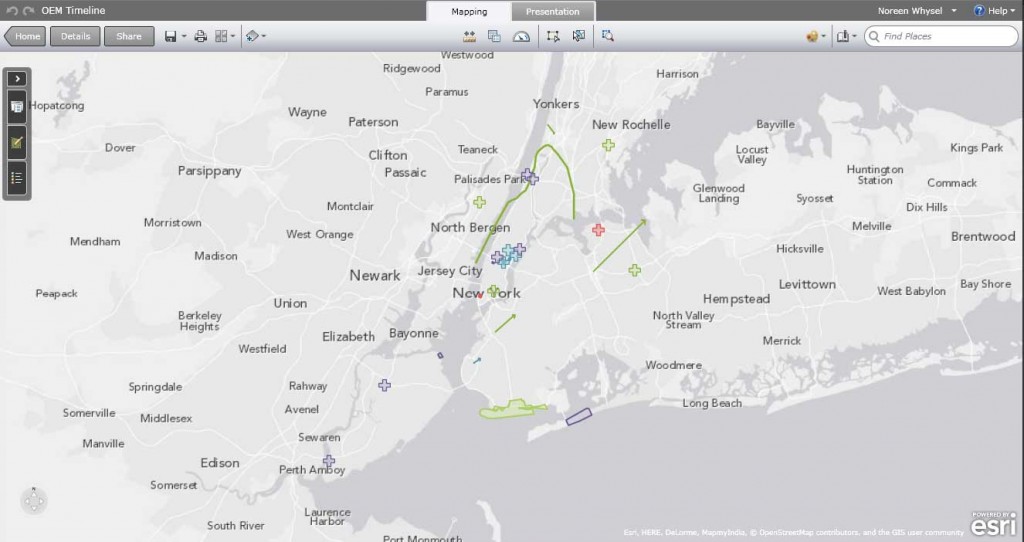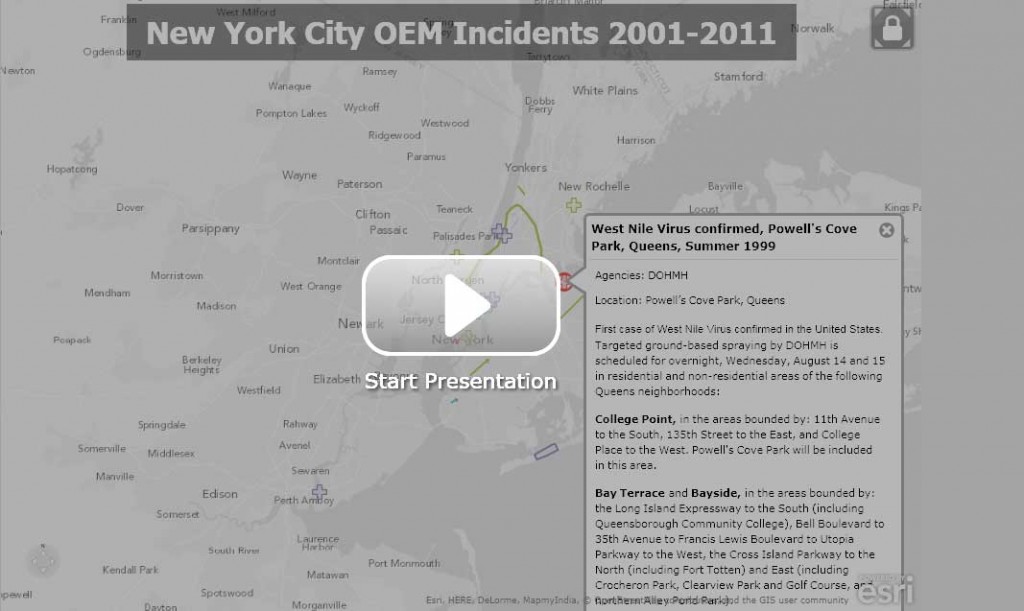The following is a Findings Report on web map resources that I completed as part of a study of NYC Community Gardens for Pratt’s Map Institute at the New York Public Library Map Division taught by Matt Knutzen. I reviewed the Library of Congress Geography and Map Reading Room website, GeoCommons and OASISNYC as potential resources for completing this project.
Library of Congress Geography and Map Reading Room
http://www.loc.gov/rr/geogmap/
The Library of Congress Geography and Map Reading Room website contains information about visiting and using the institution’s physical and digital library resources. Major sections of the website include information about the history and background of the Map Division, reference services, digital collections, acquisitions and the Philip Lee Phillips Society friends of the library group.
The center of the page offers links to a featured Map of the Peninsula of Florida by Joan Vinkeboons labeled with the date [1639?]. Clicking the map opens it in the Division’s map viewer. There are two additional links that open the “new map interface” and an older “American Memory format” which appears to be from a 1999 project. The information in the right column contains library hours, Ask a Librarian online request form and a current, featured map project, “Places in History: 150th Anniversary of the U.S. Civil War (2011-2115).” ([sic] 2115 appears to be a typo).
The links were a bit confusing at first since I had expected the label “Geography & Map Division Map Collections using a new interface” would lead to a press release or a guide to the new interface. Instead it leads directly to the main page of a catalog tool for digital holdings. The American Memory format link leads to the American Memory project which appears to have been created in 1999. The interface retains the look and feel of that era of web development, and contains a useful, browsable subject and title index as well as search. The Places in History links also link to the older American Memory interface if you click the map itself. If you click the “more” pr “learn more” links you can retrieve more detailed information in a modern interface, including links to the catalog records for cited maps, the KML file in some cases, and a link for ordering reproductions.
The American Memory interface allows you to zoom into smaller portions of a map via JPEG2000 images at various resolutions and zoom levels. The modern interface is the Library of Congress’ general catalog search filtered to the map collection. This includes a search bar with Maps selected and search results showing a summary of listings, including catalog information. Facets allow you to filter by original format, online format, date, collection, contributor, subject, location and language. This integrates the Map collection with the larger LOC catalog, providing access and discovery. An addition to this search page that is unique to the Map Division is tabs labeled “Search Maps” and “Map Collection” which offer the ability to search or browse the collection. Detailed information about the Map Viewers is another useful page included in the Digital Collections section.
From the standpoint of a researcher seeking to utilize the collection, the links on the left column of the home page describing reference policies, guides to the collection, finding aids and a link to the Online Map Collection are most useful. Reference policies describe how one can gain access to the collection and services available including how to obtain a Reader Identification Card, how to make inquiries from a distance and the kinds of copying services available, including reminders about appropriate citation and copyright permissions.
Finding aids and collection guides appear to be similar concepts, though the finding aids, of which there are only three, are EAD encoded resources while the collection guides are web pages with brief descriptions and essays. A few, such as the American Women project, are multipage, curated websites. The collection guides are not uniform in layout. Some point to materials in the old American Memory format, while others are displayed in the new format that is browsable by Title, Subject, Audio, Photograph, Drawing, Video, and Written Narrative.
While I expected the NYPL will have more materials that are relevant to my research in community gardens, I wanted to look at the Library of Congress site particularly as a complement to the NYPL resources. I did find an interesting aerial mosaic of the neighborhood where my garden is located from 1929, showing some buildings that are still there and others that have since been demolished or replaced. It is interesting to see that certain surrounding features in nearby Central Park and the relative widths of major versus minor streets are still the same today as they were at the time the photographs were taken. Unfortunately, some of the detail is difficult to discern.
GeoCommons
http://geocommons.com
GeoCommons is a public community website of ESRI GeoIQ users, who according to the website, “are building an open repository of data and maps for the world.” The GeoIQ platform includes a features for uploading, accessing, visualizing and analyzing data. Some of these features include the ability to create and share custom maps with layered data and animations through time and space. The platform allows you to upload your own data, and it will create statistics that you can analyze and download in many formats, including CSV, KML, ESRI Shapefile, JSON and Atom. Additionally, site viewers can search for and access your map, filter the data, copy it to their own accounts so they can add or modify the data and share the results.
GeoCommons serves as an introduction to ESRI’s GeoIQ enterprise edition which contains more powerful predictive analytics tools, integration with social media and the ability to keep data private and to manage access and workflow. Data can be stored in the cloud or hosted on a virtual machine. GeoIQ Connect can integrate with Oracle, MySQL, PostgreSQL, ESRI, MongoDB, and other datastores and APIs. Also, a free developers kit allows you to create custom applications that integrate with GeoIQ.
Reviewing GeoCommons from the perspective of a community garden organizer, it seems that the free version would be sufficient for most uses. Gardens could be plotted on a map and compared to surrounding land uses and current and proposed planning and construction projects. Individual gardens might like to use GeoCommons to create plot maps of members beds. My local community garden recently installed a beehive, so it would be an interesting project to plot areas where bees are found in the garden.
Most community gardens are not large enough or rich enough to purchase an enterprise edition; however, if it were purchased by the City Parks Department, it could conceivably be used to host and manage users who are affiliated with the department’s Operation Green Thumb gardening program. Advocacy groups might like to use it to promote development of gardens in areas of greatest need. For example, the NYC Parks Department website indicates that many community gardens have historically been created in areas where access to open public spaces is limited. An existing NYC community garden map on the GeoCommons site shows a concentration of gardens in the Lower East Side and East Harlem in Manhattan and Bedford-Stuyvesant and East New York in Brooklyn.
As a research and reference tool GeoCommons is limited to the datasets that have been uploaded by site users. ESRI offers a search tool for discovery and showcases featured maps, but there is no formal index and the community of maps run the gamut from formal studies to test runs, such as the one I created to play with a community garden map that I found. As a tool for teaching basic GIS skills, the site is quite useful. It is very easy to upload data and play with the basemap and icons, and the download formats offer a way to work easily with spreadsheet views or Google Earth.
OASIS
http://www.oasisnyc.net/map.aspx
OASIS map focuses in open space in New York City. It is maintained by the Center for Urban Research at CUNY Graduate Center. It was one of the first maps created specifically to address the low ratio of open space per citizen. It is an excellent research tool for highlighting open space and comparing to surrounding land uses.
OASIS is a collaborative project between CUNY and a number of data providers including the US. Army Corps of Engineers, the Wildlife Conservation Foundation, the Stewardship Mapping Project, the USDA Forest Service, the Manahatta Project and the Council on the Environment of NYC’s community gardens program. The diversity of partners, most of whom contributed data to analyze specific problems, is a testament to the various use cases and array of visualizations possible with this tool. The platform that OASIS runs on is ESRI ArcGIS Server with OpenLayers open source map viewing library and Javascript web framework, JS Ext.
In addition to open space and land use data, OASIS includes data layers showing transit lines, such as roads, subways, bus lines and bike routes; environmental data such as coastal storm impact zones, Forever Wild sites, and public access waterfronts; environmental impact zones, such as brownfields, hazardous waste treatment centers and volunteer cleanup sites; social services such as schools, libraries, and NYCHA and subsidized housing properties; as well as zoning, population characteristics, water and wetland areas, political boundaries and historical datasets.
It is possible to overlay data onto historical aerial photography from 1996 to 2008 via a slider interface. Also, because the map is linked to the Manhatta project, you can display recreated aerial landscapes from 1609 and overlay it with data from that period, including wildlife habitats, Lenape Indian trails, eco-community data and shorelines. Additional historic overlays include Montresor map from 1775, the Poppleton map from 1817, the Viele map from 1874, and the Bromley Atlas from 1911 (all maps from New York Public Library).
It is a powerful discovery tool. If you select a property on the map, the Location Report tab offers detailed information about the property, including tax block and lot information, owner, property dimensions, like building area, number of units and whether commercial space is included, political and community district information and other relevant information. It also has direct links to the property’s Zoning Map, NYC Dept. of Buildings and transaction records, tax assessment the Digital Tax Map, NYC zoning guide and NYC Watershed Resources.
OASIS is a good website for garden organizers. In fact, community gardens was one of the earliest projects that ran on OASIS. It lists community garden search as one of the main features on the homepage, along with special searches for stewardship organizations, such as block associations and historical societies. It functions well as a directory for these kinds of community organizations since the metadata may include contact information, website address, hours, membership and other pertinent information about the entity in addition to property information such as ownership, block and lot number and political jurisdiction.



